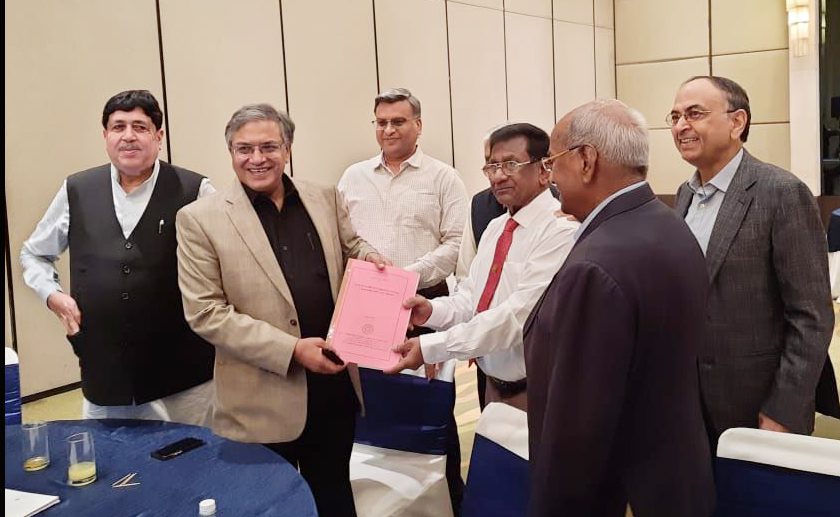Bhima Subrahmanyam, MD of NAFSCOB presented the final draft study report on ‘Need of Credit in Cooperative Sector, Constraints and ways ahead’ to Gyanesh Kumar, Secretary, Ministry of Cooperation.
It bears recalling that recognizing the importance of cooperative sector in the overall economic development of the country, the Cooperation Ministry entrusted a study themed ‘Need of Credit in Cooperative Sector, Constraints and ways ahead’ to the NAFSCOB.
Those present on the occasion of submission of this report included NCUI President Dileep Sanghani, Dr U S Awasthi Dr. Bijender Singh, Jyotindra Mehta and P.S.Gahlaut, MD IPL. Pankaj Kumar Bansal, Joint Secretary and In-charge MD of NCDC was also present.
The present study confines to the requirement of both short term and long term credit in the cooperative sector purveyed through the Short Term Cooperative Credit Structure (STCCS), said Bhima underlining that the problems of the LTCCS being different from the STCCS, it is desirable to take-up a separate study to address the issues of LTCCS.
The study reports that the STCCS with 1,14,542 outlets (including PACS numbering 1,02,559) outnumbered the total network of Commercial Banks and RRBs at 93,832 branches in rural and semi-urban areas. The STCCS caters primarily to the production credit needs and to some extent investment credit needs of the agri and allied sectors.
Functional societies particularly in the handlooms, fisheries, dairy, sheep breeders, industrial cooperatives, labour contract societies etc., are many times more than the number of PACS in the country. The STCCS should initiate a plan of action for financing the functional societies in the next 5 years which would generate additional demand for credit many fold.
There are several cooperative federations operating at District and State Level. Many of these federations are not being financed by the STCCS. The SCBs/DCCBs should explore the possibility of financing these federations as a strategy to build their aggregate loan portfolio.
Similarly, there are several opportunities for the SCBs/DCCBs to extend loans for Cooperative Housing Societies, individual housing loans, education loans, gold loans, transport sector etc. Only three SCBs viz., Andhra Pradesh, Gujarat and Tamil Nadu have enrolled as Member Lending Institutions with Mudra Bank. There is a tremendous scope for extending retail loans under the Pradhan Mantri Mudra Yojana (PMMY) for DCCBs and SCBs.
To meet the credit requirements of all the existing members of PACS at the NSO national average of ?74,121, the total disbursements of PACS have to increase from the existing ?2.29 Lakh Cr., during 2020-21 to ?10.16 Lakh Cr., by FY 2027-28.
To support the expected disbursement of loans at PACS level in the next 5 years. DCCBs will have to step up their disbursements maintaining the same leverage ratio. To support the expected disbursement of loans at DCCBs level in the next 5 years. SCBs will have to step up their disbursements by maintaining the same leverage ratio.
Focused attention should be given to the development of PACS. Each DCCB and SCBs in case of 2-tier structure should have dedicated PDCs to focus on the development of PACS.
The NABARD’s scheme of PDCs may be revisited to suit the present requirements and provide appropriate funding support.
Besides computerization of PACS, they do not have proper infrastructure like office building, banking counters, furniture, safe, godowns etc., which affects their visibility. The infrastructure requirements of all the viable and potentially viable PACS in each state should be assessed and such infrastructure should be provided at the earliest.
The scheme of PACS as MSC launched by NABARD should be extended to all the viable PACS instead of limiting to 35,000 PACS. Eventually, the scheme should also be extended to all other potentially viable PACS and also proposed new PACS.
More than 10% of the PACS (12,014) have been categorized as dormant and defunct. There is a need to revive these PACS or setup new PACS where such revival is not possible.
Further, there is a need to set up new PACS in the underserved and unserved areas. PACS being born FPOs, financial assistance on the lines of FPOs may be extended to PACS towards equity and management cost.
DCCBs and SCBs should launch new deposit schemes on a mission mode and aim at increasing their market share of deposits to at least 10% market share in the next 5 years with special focus on increasing CASA deposits.
Branch licensing policy for SCBs in 3-tier also may be revisited, enabling them to open branches in places other than the state headquarters.
Governments should revisit their policies for keeping deposits in banks and give preference to DCCBs and SCBs at least to the extent of their share in the priority sector loans. This would strengthen not only public confidence in these banks, but also augment their CASA deposits.
The Govt. of India has been extending financial support by way of equity contribution to Public Sector Banks and RRBs to comply with CRAR and other statutory requirements. On similar lines, the government should extend financial support to DCCBs and SCBs.
The policy or administrative decision of Govt of India to allow only scheduled commercial banks to open Single Nodal Agency (SNA) Accounts of State Government/ Agencies for Centrally Sponsored Schemes , and shift the SNAs already being maintained by Scheduled SCBs to Scheduled commercial banks needs to be withdrawn with immediate effect as it adversely affect the financial stability scheduled SCBs in North Eastern Region.
The Government of India needs to honour its commitment made for recapitalisation support as per the recommendations of AV-1 to PACS to allow them to cater to the needs of farmers ,in few states by releasing their share as the state governments have already released their share as per the MOUs.
